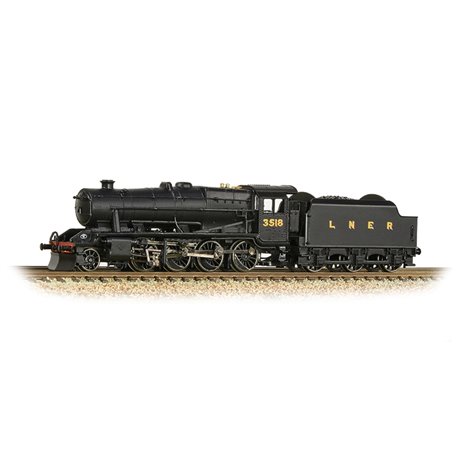No products
Product successfully added to your shopping cart
There are 0 items in your cart. There is 1 item in your cart.
 View larger
View larger LNER O6 3506 LNER Black (LNER Revised)
372-160
Graham Farish
LNER O6 3506 LNER Black (LNER Revised)
Featuring a powerful loco-drive mechanism using a coreless motor and in the tender, you will find a NEXT18 DCC decoder socket along with a pre-fitted speaker making it easy for sound to be added too. NEM coupling pockets are fitted to the front and rear, and fine detailing can be found across the model - from the metal handrails to the cylinder drain cocks, brake blocks and turned-metal safety valves.
Inside the cab is a wealth of detail, whilst a hinged fall-plate is fitted between the locomotive and tender ready to accommodate a suitable crew from the Scenecraft figure range, we think the Steam Locomotive Staff (379-307) are ideal!
This product is out of stock
| Scale | N (1/148 - 1/160) |
More info
LNER O6 3506 LNER Black (LNER Revised)
Featuring a powerful loco-drive mechanism using a coreless motor and in the tender, you will find a NEXT18 DCC decoder socket along with a pre-fitted speaker making it easy for sound to be added too. NEM coupling pockets are fitted to the front and rear, and fine detailing can be found across the model - from the metal handrails to the cylinder drain cocks, brake blocks and turned-metal safety valves.
Inside the cab is a wealth of detail, whilst a hinged fall-plate is fitted between the locomotive and tender ready to accommodate a suitable crew from the Scenecraft figure range, we think the Steam Locomotive Staff (379-307) are ideal!
- Graham Farish N Scale
- Era 3
- Pristine LNER Black (LNER Revised) livery
- Loco-drive Mechanism
- Tender Pick-up
- Coreless Motor
- Accessory Pack
- NEM Coupling Pockets
- NEXT18 DCC decoder socket
- Recommended for use with Decoder 36-567
- Sugar Cube Speaker Fitted
- Length 140mm (over couplings)
HISTORY
The London Midland and Scottish Railway's 8F class 2-8-0 heavy freight locomotive is a class of steam locomotive designed for hauling heavy freight. 852 were built between 1935 and 1946 (not all to LMS order), as a freight version of William Stanier's successful Black Five, and the class saw extensive service overseas during and after the Second World War. The type was extremely successful at doing what it was designed for, it was long-lived - to the end of British Rail steam in August 1968, and extremely widely travelled across the Midlands and Northern England into Scottish region and parts of Wales.
The 8F design incorporated the two-cylinder arrangement of the Black Fives. They were initially classified 7F, but this was later changed to the more familiar 8F. On the outbreak of the Second World War, the design was chosen to become the country's standard freight design, reprising the role the GCR Class 8K had in the First World War. The War Department had 208 8Fs built by Beyer Peacock and North British Locomotive Company and requisitioned 51 more. Stanier 8F production for the WD continued until 1943, when the cheaper WD Austerity 2-8-0 was introduced. Production for British domestic use continued until 1946.
Some 331 locomotives were built for the London Midland and Scottish Railway between 1935-45. A further 245 were built by the London and North Eastern Railway, Great Western Railway and Southern Railway in 1943-45 for LMS stock, though mostly retained on loan by the other railways during the war. The LNER also purchased 68 Stanier 8Fs for its own use in 1944-46, classifying them O6, though these were also sold to the LMS after the war. As noted above, 51 LMS locomotives were requisitioned by the WD in 1941, but 31 WD locomotives were subsequently purchased by the LMS in 1943 (including 8 of the requisitioned engines).
624 8Fs passed into British Railways ownership when Britain's railways were nationalised in 1948. A further 39 (10 requisitioned) were purchased from MEF stock in 1948, and a final 3 (1 requisitioned) from the Longmoor Military Railway in 1957, bringing the total to 666. The 8Fs were concentrated on the London Midland Region, but were also allocated to former LMS sheds on other regions. Despite some having operated in Scotland by the LMS, they were not common on the Scottish Region under BR ownership as the later WD 'Austerity' 2-8-0 and 2-10-0 types were used instead. The 8Fs were successful and durable locomotives in BR service, with all 666 locomotives surviving until 1960 and routine withdrawals not beginning until 1964. The first to go in 1960 was 48616, followed two years later by 48009. 48773–48775 (the former Longmoor Military Railway locomotives which were the only 8Fs on the Scottish Region) were also withdrawn in 1962, but these were reinstated into London Midland Region stock in 1963. The remaining 664 were withdrawn between 1964 and 1968, with 150 surviving to the last year of steam on BR. Fourteen examples survive in preservation including some repatriated from Turkey.

